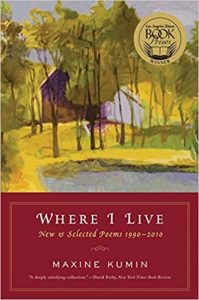
Bonnie Tsui’s Why We Swim is published this month. She shares five books about immersion in worlds and water.
Creatures by Crissy Van Meter
This lush, beautiful novel is all about how the sea infiltrates the life of an island and that of a girl who grows up there—it’s a mesmerizing backdrop to a family drama about love and abandonment. It starts with a dead whale being trapped in the harbor.
Jane Ciabattari: Do you have favorite passages or scenes from Creatures?
Bonnie Tsui: I mean, the opening scene is just ravishing. “There is a dead whale. It rolls idly in the warm shallows of this island, among cartoonish sea animals with tentacles, suction cups, and goopy eyes.” It throws you right into the thick of the marine environment, amidst the beautiful and the ugly, and lets you know that the ocean is a compelling main character in this story.
Swimming Studies by Leanne Shapton
A gloriously inventive visual and literary autobiography of Shapton’s history as a swimmer, done in a series of exquisite sketches.
JC: Swimming Studies won the 2012 National Book Critics Circle Award for Autobiography, a tribute to the poetic quality of her language and the shimmering artistry of her imagery. But she’s also highly trained, making the Canadian Olympic trials in the breast stroke twice. “I still dream of practice, of races, coaches and blurry competitors,”: she writes. “I’m drawn to swimming pools, all swimming pools, no matter how small or murky. When I swim now, I step into the water as though absent-mindedly touching a scar. My recreational laps are phantoms of my competitive races.” How do you think this layer of her immersion in swimming helps make her memoir powerful?
BT: Her experience of swimming now is that of a person who is possessed by the ghost of a past life. That other person was a champion who tasted glory. She can never quite escape that ghost, because it keeps sneaking in and coloring her every present encounter with the water. That’s really poignant.
The Ocean at the End of the Lane by Neil Gaiman
A fantastical story about childhood and memory that uses the ocean as metaphor, with all of its glory and menace.
JC: The narrator returns to a boyhood home in rural Sussex, revisiting a duck pond near a farmhouse where he knew three generations of women with supernatural abilities—Lettie, a girl near his age, her mother and grandmother. How does Gaiman make that duck pond achieve oceanic proportions?
BT: It’s all in the details—the unexpectedly vivid way Lettie’s mother answers the narrator’s innocent question about how Lettie called the duck pond “the sea”: “Can’t drink the water from the sea, can you? Too salty. Like drinking life’s blood.” Or the way Lettie nets a dead fish out of the pond and cuts a silver sixpence out of it… which then (horror of horrors!) ends up inside the narrator’s mouth during a terrifying dream.
The Waves by Virginia Woolf
This book quite literally moves like water—the voices of various characters lap over each other, as does time, moving from the era of childhood to old age.
JC: The Waves is one of my favorite books. Six voices, images of a fin, silver fish, bubbles, time passing, waves lapping, overlapping. How did The Waves influence the rhythms in Why We Swim?
BT: The single voices come together in a chorus, revealing how our individual lives feel big close up but are insignificant to the outside world; paradoxically, it also has the effect of creating a larger consciousness, of humanity. I love that friction. I tried to do the same with Why We Swim, to have specificity with imagery and characters and stories, but to also have them converge in thematic beats that take you through the whole book.

Where I Live—New & Selected Poems 1990-2010 by Maxine Kumin
Maxine Kumin wrote sharp, observant poetry about the natural world and her place in it, and in particular about her lifelong relationship with swimming. Her poem “Morning Swim” was a touchstone for me while I was writing my book.
JC: She brings you into the water with her in that poem. “Fish twitched beneath me, quick and tame. In their green zone they sang my name and in the rhythm of the swim I hummed a two-four-time slow hymn.” Which elements of “Morning Swim” most helped you shape Why We Swim?
BT: The immediacy of her observations reminded me that I needed to insert more vivid moments in the book of what it’s like to just swim—a book about swimming has to have actual swimming in it. This may seem glaringly obvious, but the crispness of the rendered experience makes a big difference.
*
· Previous entries in this series ·

